
Figure 1.--This photograph is unidentified, but it looks to us that it might be highschool boys in the late 1930s. The younger boys wearing knickers may be a junior highschool student. Notice the ties and sweaters. |

|
American boys have worn a wide range of garments to schools. These garments have varied over time and there have also been regional differenes. The type of school was also of some importance. American boys for the most part did not wear uniforms. There are a few exceptions such as military and preparatory schools and a few private schools. American boys simply wore their regular clothes, often somewhat more formal than play clothes. This however changed over time. We see garments like sailor suits and knee pants suits in the early 20th century. Many boys wore corduroy knickers to school. Most boys wore long pants to school in the 1950s, but shorts were also worn by some areas. This varied regionally and chronolgically. Pimary boys by the mis 20th century were wearing more casual clothes such as "T"-shirts and jeans. To our knowledge American boys did not wear smocks, but they were worn at some schools for art classes. Cold weather garments were important during the Winter, especially in the northern states. Most boys had raincoats for inclemet weather.
American school children for the most part did not wear uniforms. There are a few exceptions such as military and preparatory schools and a few private schools. A rare exception was Federal boarding schools for Native American children (late-19th century). Seeing assimilation as the only real future for the children, children were forcibly taken away from their families andtaken to boarding schools. The children at these schools were commonly dressed in military-style uniforms. Here we will deal with military schools and the uniform garments separately because they are so specialized. Private school uniforms, other than military schools, were largely based on the destinctive uniforms worn at British public (private boarding) schools. Several different garmenhts were worn at the schools. Peaked school caps were common. Uniforms began to become more popular after World War II. The parochial schools were the first to commonly adopt very basic uniforms, actually more like uniform dress. The school uniform movement in the public schools began later (late-1980s). 【Brunsma】 Many inner-city primary schools began adopting uniforms in the 1990s. Normally they were not compulsory. And new kinds of private schools appeared, especially those founded by conservative Christian religious groups, disturbed by the increasing secularization and permissiveness of the public schools. The rise of gang violence and discipline issues resulted in American public schools to begin to consider school uniforms. The first school made the decision as a result of a Baltimore school shooting over designer sun glasses (1986). There was also growing concrn over the poor results in man urban schools with minority student bodies. Two unrelated schools are believed to have laynched the school uniform movement. They weere elementary schools in Maryland and Washington, DC (fall 1987). Cherry Hill Elementary School in Baltimore, Maryland resulting in considerable publicity. They made the school uniform voluntary, but yjere was consideravle support from parents.
【NYT, December 1987】 And most of the students wore the uniforms. School officials and others described improvements. Apparently itchange the children's 'frame of mind' and fewer discipline problems. Another positive impact was according to one school official was that that the uniforms had 'already reduced the preoccupation of students with expensive designer clothing for school wear and eased the financial burden that placed on the students' families.'
American boys simply wore their regular clothes, often somewhat more formal than play clothes. This however changed over time. We see garments like sailor suits and kneepants suits in the early 20th century. Many boys wore corduroy knickers to school. Most boys wore long pants to school in the 1950s, but shorts were also worn by some areas. This varied regionally and chronolgically. Pimary boys by the mis 20th century were wearing more casual clothes such as "T"-shirts and jeans. To our knowledge American boys diud not wear smocks, but they were worn at some schools for art classes. Cold weather garments were important during the Winter, especially in the northern states. Most boys had raincoats for inclemet weather. A reader writes, "I was talking with a friend about changing fashions. She
told me that when she was in middle school in Berkeley in the late 1940s, boys wore unwashed corduroys, letting them get as dirty as possible. They also liked to wear them as low as possible. Things go in cycles! I also asked her about blue jeans. She said that boys in this area were never prohibited from wearing jeans at either the schools she attended or at the schools she taught at. The prohibition was against girls wearing jeans to high school, which was finally lifted in the mid-1960s. Today it's rare to find a girl who isn't wearing jeans. The dresses and skirts that used to be everyday wear are now reserved for special occasions."
We have not yet worked on school shoes. We do note, however, an interesting article about the Portland public schools which taught boys shoe repair.
Most school school garments were worn at both uniform and non-uniform schools. In Britain, the school uniforms at public (private boarding) schools helped popularizwe a variety of garments styles for school wear. This was not the case in America as the private schools were not as inflential as in Britain. For the most part, American boys just wore their regular clothes to school, although they tended to dress up until the 1930s. These pages are needed in part so we can link school paragraphs from the main garment pages. We note peaked caps beung worn at both uniform and non-uniform schools.
We note American school children sometimes dressed up in outfits for special occassions. This includes holiday events ans well as special school occassions. May Day used to be a major event in American schools in which the children were often dressed up, often in white, for a range of events, especially May Pole ceremonies. We note an unidentified elementary school in 1939. It looks like an 8b year elementary school in a small town. The Kindergartners are dressed up in sailor outfits and were joined by the older boys in the school band. We are not sure what the event is, but it was the end of the school year.
We note boys ding calesthetics in the early 20th cebntury. They look to be wearing their own clothes rather than gym unifirms. We are not sure when gym uniforms were fitst worn. We think that they were being commonly worn in high schools by the 1920s. Gym or Physical Education (PE) used to be an important part of the school program, especially at the secondary level. Primary (elementary) schools did not always have PE classes and did not have special gym clothes or uniforms. This was different in secondary clothes. PE was a class and grades were given. There were uniforms and most schools were strict about wearing the proper gym clothes. This changed in the 1970s when school dress codes and gym uniform requirements were significantly relaxed. The PE program was also deemphasized at many schools. A HBC reader has provided us some information about his gym experinces: Gym uniforms in California during the 1960s-70s.
A range of gear is associated with American school children. These itemns are mostly associated with books and lunch. At first as far as we know this involved a leather belt. I don't think this began until the 19th century. Two factoirs are at play here. First, belts were not commonly used to hold up trousers in the 17th and 18th centuries. Second, books and paper were expensive and children did not have much to take back and forth to school. Rather children used slates to do school work. Only in the mid-19th century do we see children taking books home from school. And they are often depicted taling them home bound together with a leater belt. American children never had book satchels like German chilldren. After World War II we begin to see backpacks. I recall using an old army back pack. At first only the boys used them. Eventually we begin to see purpose-made school backpacks in bright colors and all kinds of special features. We note children taking lunch pails to school in the late-19th century. They were the same as workers took to work. In the 20th century we begin to see lunch boxes. Until after World War II, few schools had cafeterias. Children brought a lunch or came home for lunch. We are not sure when lunch boxes first appeared, but see them in the 1930s. There were plain lunch boxes and soon we see boxes decorated with popular figure from Shirely Temple to Hopalong Cassidy. This gradually declined as more schools added cafeterias and free lunch programs.
Brunsma, David L. The School Uniform Movement and What It Tells Us about American Education: A Symbolic Crusade (2004).
New York Tines (December 1987).
Related Chronolgy Pages in the Boys' Historical Web Site
[Main Chronology Page]
[The 1900s]
[The 1910s]
[The 1920s]
[The 1930s]
[The 1940s]
[The 1950s]
[The 1960s]
[The 1970s]
[The 1980s]
[The 1990s]
[The 2000s]
Navigate the Relate Boys Historical Clothing Style Pages
[Main country page]
[Long pants suits]
[Short pants suits]
[Lederhosen]
[Kneesocks]
[Eton suits]
[Jacket and trousers]
[Blazer
[School sandals]
Navigate the HBC Country School Pages
[Return to the Main U.S. School Page]
[Return to the Main National School Page]
[Australia]
[England]
[France]
[Germany]
[Ireland]
[Italy]
[Japan]
[New Zealand]
[Poland]
[Singapore]
[Scotland]
[Singapore]
Navigate the HBC School Section:
[Activities]
[Chronology]
[Clothing styles]
[Countries]
[Debate]
[Economics]
[Garment]
[Gender]
[Hair]
[History]
[Home trends]
[Literary characters]
[School types]
[Significance]
[Transport and travel
[Uniform regulations]
[Year level]
[Other topics]
[Images]
[Links]
[Registration]
[Tools]
[Return to the Historic Boys' School Home]
